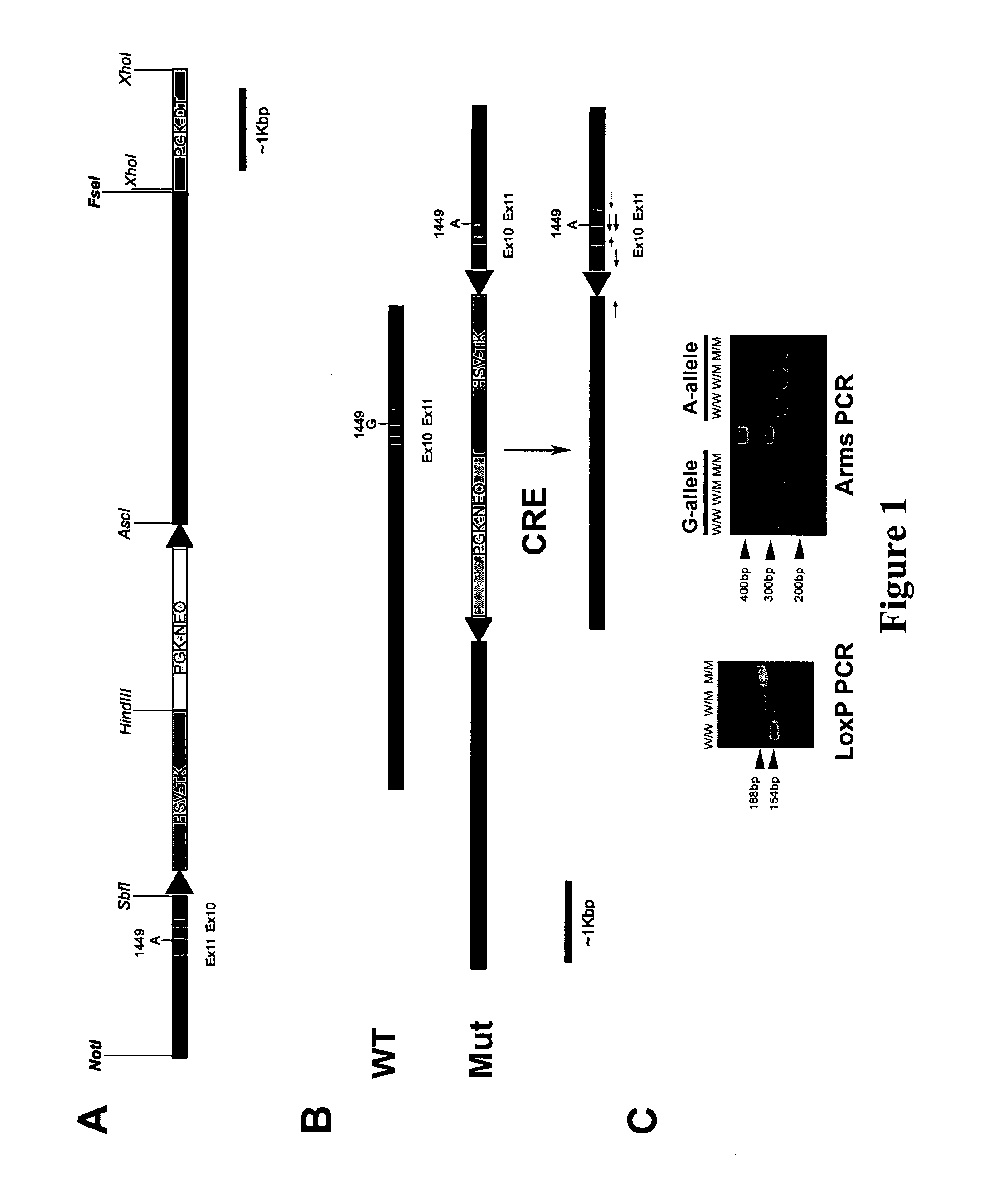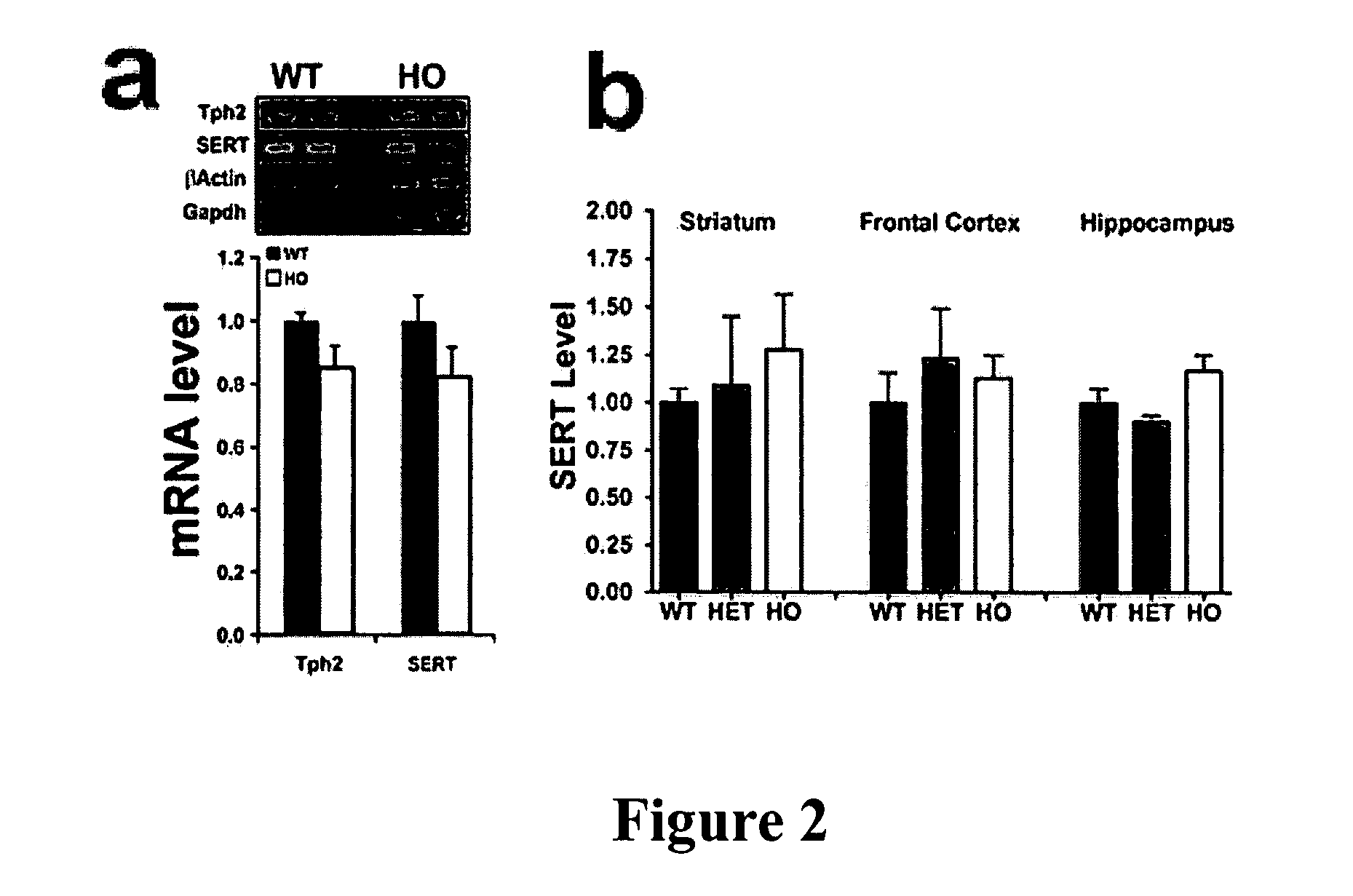Mammals carrying functional single nucleotide polymorphisms in brain-specific tryptophan hydroxylase
a tryptophan hydroxylase and single nucleotide polymorphism technology, applied in the field of engineering of nonhuman mammals having a mutant tryptophan hydroxyase 2, can solve the problem that the contribution of other genetic variations in these mice cannot be ruled ou
- Summary
- Abstract
- Description
- Claims
- Application Information
AI Technical Summary
Benefits of technology
Problems solved by technology
Method used
Image
Examples
example 1
Generation of R439H Tph2 Knock-In Mice
[0051]“Knock-in” mice carrying the R439H mTph2 allele equivalent to the R441H hTPH2 allele identified in major unipolar depression patients (Zhang et al., 2005, Neuron 45:11-16) were produced as follows. A 4.6 kb “long arm” (SEQ ID: 1, See Table 2 below) and a 2.0 kb “short arm” (SEQ ID: 2, See Table 3 below) were cloned by PCR using EXL® DNA polymerase (Stratagene, La Jolla, Calif.) using genomic DNA obtained from 129S6 / SvEv mice as a template. The long arm corresponded to sequences from mTph2 intron 9, while the short arm contained intron 9 sequences as well as exon 10, intron 10, exon 11, and about 1 kb of the 3′UTR of the mTph2 gene. To engineer the R439H, the guanine 1449 encoded in exon 11 was changed to an adenine using site directed mutagenesis. The long arm and short arm were then subcloned to a targeting vector, resulting in the insertion of a floxed herpes virus thymidine kinase / neomicine (TK / NEO) selection cassette in the ninth intr...
example 2
Evaluation of Serotonin Synthesis in the Brain of Tph2 R439H Knockin Mice
[0056] For all experiments involving knock-out or knock-in animals, respective WT littermates were used as controls, and all mice were 3-4 months of age. Before experiments, animals were housed 4-5 / cage in a humidity-controlled room at 23° C. with a 12 hr light / dark cycle with ad libitum access to food and water. Experiments were conducted with an approved protocol from the Duke University Institutional Animal Care and Use Committee and experiments conducted according to National Institutes of Health guidelines.
[0057] Methods used to analyze levels of 5-HT and 5-HTP using HPLC and electrochemical detection were as described (Zhang et al., 2004, Science 305:217). The 5HT synthesis rate in vivo was measured in mice treated with 100 mg / kg (i.p.) of m-hydroxybenzylhydrazine (NSD-1015) for 1 hr (Zhang et al., 2004, Science 305:217). Data from neurochemical studies and western blot were analyzed by two-tailed t-tes...
example 3
R439H Knock-In Mice Exhibit Behavioral Differences in Tests Used to Assess the Actions of Antidepressants
[0061] Assessment of “behavioral despair” is the most common approach used to assess actions of antidepressants in mice (Crowley et al., 2004, Pharmacol. Biochem. Behav. 78:269-274; Lucki et al., 2001, Psychomparmacology (Berl) 155:315-322). In the Porsolt forced-swim and the tail-suspension tests, drug-induced reductions in immobility times are predictive of antidepressant activities of drugs.
[0062] Tail Suspension Test:
[0063] Mice were tested in a tail suspension apparatus (Med-Associates, St. Albans, Vt.) as described (Crowley et al., 2004, Pharmacol. Biochem. Behav. 78:269-274). All mice were weighed and tail-marked 24 hrs before testing. Animals were brought into the testing room 4 hrs before injections. Pilot studies were used to determine the optimal automated threshold settings for immobility by comparing scores rated manually with scores tabulated simultaneously by th...
PUM
| Property | Measurement | Unit |
|---|---|---|
| Fraction | aaaaa | aaaaa |
| Fraction | aaaaa | aaaaa |
| Fraction | aaaaa | aaaaa |
Abstract
Description
Claims
Application Information
 Login to View More
Login to View More - R&D
- Intellectual Property
- Life Sciences
- Materials
- Tech Scout
- Unparalleled Data Quality
- Higher Quality Content
- 60% Fewer Hallucinations
Browse by: Latest US Patents, China's latest patents, Technical Efficacy Thesaurus, Application Domain, Technology Topic, Popular Technical Reports.
© 2025 PatSnap. All rights reserved.Legal|Privacy policy|Modern Slavery Act Transparency Statement|Sitemap|About US| Contact US: help@patsnap.com



